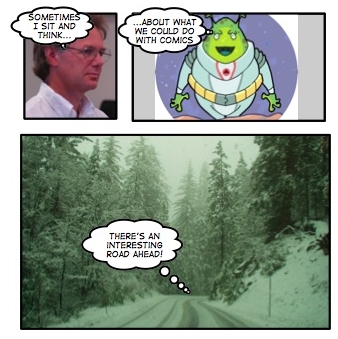I decided to elaborate a bit more on my comment that I think comics/cartoons are underused in learning, as I truly believe this. I’ve used them in elearning to serve as a motivating example, humorously exaggerating the negative consequences of not learning the material. I’ve also used them as story examples, where the character models the behavior of transforming an ill-formed statement into a well-formed statement. Why?
There are some powerful reasons to consider using cartoons and comic strips (graphic novels, manga, what have you). First, we understand the world in terms of stories, in many instances, and comic strips are a great way to communicate stories. They’re concise, and can minimize the amount of literacy required. And they’re visually appealing.
Then they elegantly simplify the context. You can include the necessary components, and allow the learner’s brain to fill in the rest. That’s true too for the transition between panels (see Scott McCloud’s Understanding Comics for more). This may also facilitate the learner taking ‘ownership’ of the story, as they have to do some of the processing.
They also have one facility I really like. As Alan Shoenfeld’s work says, as I know it through Collins & Brown’s Cognitive Apprenticeship, experts need to make the underlying thought processes visible, not just the resulting steps (say, in working a problem). Thought bubbles are a great way to do this! You can do this with the ‘voiceover’ in audio and video (typically echoing slightly when it’s thoughts), but it’s easier to produce.
 Pragmatically, they can be relatively low-cost to produce, and they’re certainly low bandwidth (well, if you do it right ;). Brent Schenkler’s been talking about using ComicLife (a Mac app that lets you put speech and thought bubbles on photos) which would work as well, and then he points to tools that let you make comics! Here’s an elementary one I created with ComicLife. Not definitive, but illustrative (and doable with my limited skills).
Pragmatically, they can be relatively low-cost to produce, and they’re certainly low bandwidth (well, if you do it right ;). Brent Schenkler’s been talking about using ComicLife (a Mac app that lets you put speech and thought bubbles on photos) which would work as well, and then he points to tools that let you make comics! Here’s an elementary one I created with ComicLife. Not definitive, but illustrative (and doable with my limited skills).
Finally, they travel well. While humor might not (though certain types of humor should), the story will, as most if not all cultures have a form of comic strip and they’re easily comprehended. Practically, the internationalization and localization should be easy as well, as long as you leave enough room in the thought bubbles for languages like German translation (and keep all lettering in a separate layer).
I know, you have enough trouble talking about games in corporate settings, and comics may not be any easier, but think of the excitement of your audience, particularly young ones, talk about the lower cost to hit the global market and for lower-literacy employees. I even think they could be used to tell the corporate story (as has been done with novelizations).
Another tool I’ve just come across is MakeBeliefsComix which makes it quite easy to have characters have a dialog. The characters are limited, but it’s very easy to use.